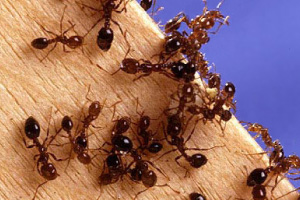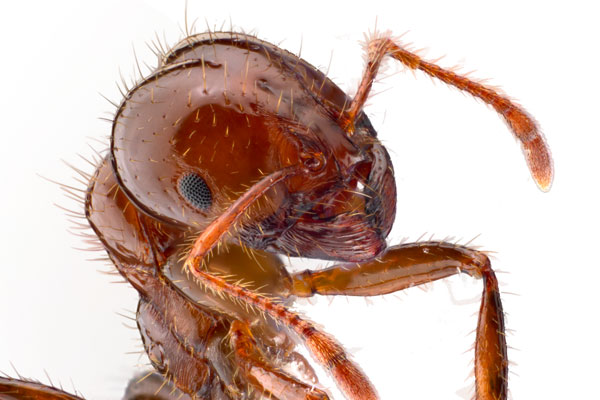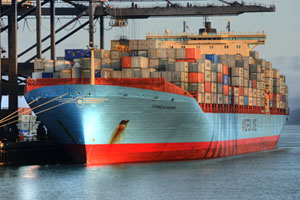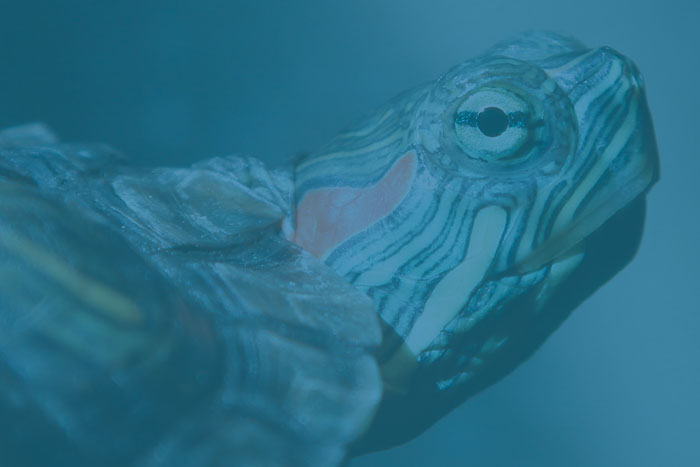
A New Bird Disease to Watch
An often fatal viral disease detected in domestic pigeons in Australia last year is here to stay and no one can tell what its impacts

An often fatal viral disease detected in domestic pigeons in Australia last year is here to stay and no one can tell what its impacts

In one of the great ecological ironies, the loss of predators can disadvantage their prey species. Top predators are ecosystem shapers, exerting control over smaller

The Australian Government intends to introduce new biosecurity laws to Parliament next month. Last week, the Invasive Species Council made a submission, endorsed by 18

After vociferous community protest, the Federal Government recently banned the 142 metre Abel Tasman ‘supertrawler’ from fishing in Australian waters while it investigates the environmental

A fact sheet with information about red imported fire ants (Solenopsis invicta) and the serious threat posed to Australia’s environment, agriculture and way of life.

This case study explains how Australia managed to achieve a major reduction in the numbers of seabirds killed as bycatch.

The interim review of the EPBC Act is a straight-talking critique that identified major weaknesses in the Act and proposes promising remedies.
Submitted: April 2020
Australia’s system for abating major threats to biodiversity: A Priority for reform of the EPBC Act. A joint submission by the Invasive Species Council and Bush Heritage Australia.

April 2020
An investigation into insects overseas that represent the greatest risks for Australia and how they could arrive in this country.

This submission responds to a request for views on the draft National Environmental Biosecurity Response Agreement (NEBRA) released by Australian national, state and territory governments in May 2019.

June 2019
Our Risks and Pathways Project set out to identify insect species from other countries that, if they ever reach Australia, have the potential to cause great harm to our natural environment.

Submitted: April 2019
A submission that responds to questions raised in the discussion paper and argues that the biosecurity levy charged on shipping imports proposed in the 2018 federal budget should proceed.

December 2018
Strengthening environmental biosecurity – stopping new species arriving and establishing and limiting the harm caused by the worst invasive species – must be a priority of the highest order to save Australian species.

Submission to the Australian Senate inquiry into the impacts of feral deer, pigs and goats in Australia, November 2018.

Submitted: September 2018A submission to the Senate inquiry into Australia’s faunal extinction crisis that addresses invasive species as extinction drivers, the importance of key threatening processes and island biosecurity and the need for ambition, inspiration, prevention and monitoring.

An often fatal viral disease detected in domestic pigeons in Australia last year is here to stay and no one can tell what its impacts

In one of the great ecological ironies, the loss of predators can disadvantage their prey species. Top predators are ecosystem shapers, exerting control over smaller

The Australian Government intends to introduce new biosecurity laws to Parliament next month. Last week, the Invasive Species Council made a submission, endorsed by 18

After vociferous community protest, the Federal Government recently banned the 142 metre Abel Tasman ‘supertrawler’ from fishing in Australian waters while it investigates the environmental

A fact sheet with information about red imported fire ants (Solenopsis invicta) and the serious threat posed to Australia’s environment, agriculture and way of life.

This case study explains how Australia managed to achieve a major reduction in the numbers of seabirds killed as bycatch.

The interim review of the EPBC Act is a straight-talking critique that identified major weaknesses in the Act and proposes promising remedies.
Submitted: April 2020
Australia’s system for abating major threats to biodiversity: A Priority for reform of the EPBC Act. A joint submission by the Invasive Species Council and Bush Heritage Australia.

April 2020
An investigation into insects overseas that represent the greatest risks for Australia and how they could arrive in this country.

This submission responds to a request for views on the draft National Environmental Biosecurity Response Agreement (NEBRA) released by Australian national, state and territory governments in May 2019.

June 2019
Our Risks and Pathways Project set out to identify insect species from other countries that, if they ever reach Australia, have the potential to cause great harm to our natural environment.

Submitted: April 2019
A submission that responds to questions raised in the discussion paper and argues that the biosecurity levy charged on shipping imports proposed in the 2018 federal budget should proceed.

December 2018
Strengthening environmental biosecurity – stopping new species arriving and establishing and limiting the harm caused by the worst invasive species – must be a priority of the highest order to save Australian species.

Submission to the Australian Senate inquiry into the impacts of feral deer, pigs and goats in Australia, November 2018.

Submitted: September 2018A submission to the Senate inquiry into Australia’s faunal extinction crisis that addresses invasive species as extinction drivers, the importance of key threatening processes and island biosecurity and the need for ambition, inspiration, prevention and monitoring.

An often fatal viral disease detected in domestic pigeons in Australia last year is here to stay and no one can tell what its impacts

In one of the great ecological ironies, the loss of predators can disadvantage their prey species. Top predators are ecosystem shapers, exerting control over smaller

The Australian Government intends to introduce new biosecurity laws to Parliament next month. Last week, the Invasive Species Council made a submission, endorsed by 18

After vociferous community protest, the Federal Government recently banned the 142 metre Abel Tasman ‘supertrawler’ from fishing in Australian waters while it investigates the environmental

A fact sheet with information about red imported fire ants (Solenopsis invicta) and the serious threat posed to Australia’s environment, agriculture and way of life.

This case study explains how Australia managed to achieve a major reduction in the numbers of seabirds killed as bycatch.

The interim review of the EPBC Act is a straight-talking critique that identified major weaknesses in the Act and proposes promising remedies.
Submitted: April 2020
Australia’s system for abating major threats to biodiversity: A Priority for reform of the EPBC Act. A joint submission by the Invasive Species Council and Bush Heritage Australia.

April 2020
An investigation into insects overseas that represent the greatest risks for Australia and how they could arrive in this country.

This submission responds to a request for views on the draft National Environmental Biosecurity Response Agreement (NEBRA) released by Australian national, state and territory governments in May 2019.

June 2019
Our Risks and Pathways Project set out to identify insect species from other countries that, if they ever reach Australia, have the potential to cause great harm to our natural environment.

Submitted: April 2019
A submission that responds to questions raised in the discussion paper and argues that the biosecurity levy charged on shipping imports proposed in the 2018 federal budget should proceed.

December 2018
Strengthening environmental biosecurity – stopping new species arriving and establishing and limiting the harm caused by the worst invasive species – must be a priority of the highest order to save Australian species.

Submission to the Australian Senate inquiry into the impacts of feral deer, pigs and goats in Australia, November 2018.

Submitted: September 2018A submission to the Senate inquiry into Australia’s faunal extinction crisis that addresses invasive species as extinction drivers, the importance of key threatening processes and island biosecurity and the need for ambition, inspiration, prevention and monitoring.
Get our blog the Feral Herald delivered to your inbox.

The Invasive Species Council was formed in 2002 to seek stronger laws, policies and programs to protect nature from harmful pests, weeds and diseases.
The Invasive Species Council acknowledges the Traditional Custodians throughout Australia and their connections to land and sea. We pay our respect to their Elders past and present and extend that respect to all Aboriginal and Torres Strait Islander peoples today.
Our protected areas are being trashed, trampled, choked and polluted by an onslaught of invaders. Invasive species are already the overwhelming driver of our animal extinction rate, and are expected to cause 75 of the next 100 extinctions.
But you can help to turn this around and create a wildlife revival in Australia.
From numbats to night parrots, a tax-deductible donation today can help defend our wildlife against the threat of invasive weeds, predators, and diseases.
As the only national advocacy environment group dedicated to stopping this mega threat, your gift will make a big difference.
A silent crisis is unfolding across Australia. Every year, billions of native animals are hunted and killed by cats and foxes. Fire ants continue to spread and threaten human health. And the deadly strain of bird flu looms on the horizon. Your donation today will be used to put the invasive species threat in the media, make invasive species a government priority, ensure governments take rapid action to protect nature and our remarkable native wildlife from invasives-led extinction, death and destruction.
If you are having trouble submitting a form, please read this guide.
Please fill out the following form and one of our team will be in contact to assist as soon as possible. Please make sure to include any helpful information, such as the device you were using (computer, tablet or mobile phone) and if known, your browser (Mozilla Firefox, Chrome, Safari etc)
"*" indicates required fields
Dear Project Team,
[YOUR PERSONALISED MESSAGE WILL APPEAR HERE.]
I support the amendment to the Kosciuszko National Park Wild Horse Heritage Management Plan to allow our incredible National Parks staff to use aerial shooting as one method to rapidly reduce feral horse numbers. I want to see feral horse numbers urgently reduced in order to save the national park and our native wildlife that live there.
The current approach is not solving the problem. Feral horse numbers have rapidly increased in Kosciuszko National Park to around 18,000, a 30% jump in just the past 2 years. With the population so high, thousands of feral horses need to be removed annually to reduce numbers and stop our National Park becoming a horse paddock. Aerial shooting, undertaken humanely and safely by professionals using standard protocols, is the only way this can happen.
The government’s own management plan for feral horses states that ‘if undertaken in accordance with best practice, aerial shooting can have the lowest negative animal welfare impacts of all lethal control methods’.
This humane and effective practice is already used across Australia to manage hundreds of thousands of feral animals like horses, deer, pigs, and goats.
Trapping and rehoming of feral horses has been used in Kosciuszko National Park for well over a decade but has consistently failed to reduce the population, has delayed meaningful action and is expensive. There are too many feral horses in the Alps and not enough demand for rehoming for it to be relied upon for the reduction of the population.
Fertility control as a management tool is only effective for a small, geographically isolated, and accessible population of feral horses where the management outcome sought is to maintain the population at its current size. It is not a viable option to reduce the large and growing feral horse population in the vast and rugged terrain of Kosciuszko National Park.
Feral horses are trashing and trampling our sensitive alpine ecosystems and streams, causing the decline and extinction of native animals. The federal government’s Threatened Species Scientific Committee has stated that feral horses ‘may be the crucial factor that causes final extinction’ for 12 alpine species.
I recognise the sad reality that urgent and humane measures are necessary to urgently remove the horses or they will destroy the Snowies and the native wildlife that call the mountains home. I support a healthy national park where native species like the Corroboree Frog and Mountain Pygmy Possum can thrive.
Dear Project Team,
[YOUR PERSONALISED MESSAGE WILL APPEAR HERE.]
I support the amendment to the Kosciuszko National Park Wild Horse Heritage Management Plan to allow our incredible National Parks staff to use aerial shooting as one method to rapidly reduce feral horse numbers. I want to see feral horse numbers urgently reduced in order to save the national park and our native wildlife that live there.
The current approach is not solving the problem. Feral horse numbers have rapidly increased in Kosciuszko National Park to around 18,000, a 30% jump in just the past 2 years. With the population so high, thousands of feral horses need to be removed annually to reduce numbers and stop our National Park becoming a horse paddock. Aerial shooting, undertaken humanely and safely by professionals using standard protocols, is the only way this can happen.
The government’s own management plan for feral horses states that ‘if undertaken in accordance with best practice, aerial shooting can have the lowest negative animal welfare impacts of all lethal control methods’.
This humane and effective practice is already used across Australia to manage hundreds of thousands of feral animals like horses, deer, pigs, and goats.
Trapping and rehoming of feral horses has been used in Kosciuszko National Park for well over a decade but has consistently failed to reduce the population, has delayed meaningful action and is expensive. There are too many feral horses in the Alps and not enough demand for rehoming for it to be relied upon for the reduction of the population.
Fertility control as a management tool is only effective for a small, geographically isolated, and accessible population of feral horses where the management outcome sought is to maintain the population at its current size. It is not a viable option to reduce the large and growing feral horse population in the vast and rugged terrain of Kosciuszko National Park.
Feral horses are trashing and trampling our sensitive alpine ecosystems and streams, causing the decline and extinction of native animals. The federal government’s Threatened Species Scientific Committee has stated that feral horses ‘may be the crucial factor that causes final extinction’ for 12 alpine species.
I recognise the sad reality that urgent and humane measures are necessary to urgently remove the horses or they will destroy the Snowies and the native wildlife that call the mountains home. I support a healthy national park where native species like the Corroboree Frog and Mountain Pygmy Possum can thrive.